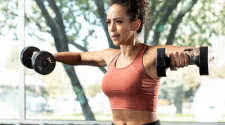The Lateral Raise Exercise - Isolate your Side Deltoid Muscles

Perform Lateral Raises Correctly & Watch Your Shoulder Grow
The lateral raise is one of the most popular shoulder exercises but also the one performed most frequently incorrectly. All
too often, bodybuilders become trapped into swinging up weights that are far too heavy to provide benefit.
Proper performance of lateral raises is to lean forward only far enough for the dumbbells to clear the tops of the thighs.
Notice that the faces of the dumbbells are forward. Throughout the movement, maintain them in that position; make sure they
remain in a plane about 10 degrees in front of the body.
Keeping your arms nearly straight, use muscular contraction in your deltoids to raise the dumbbells out to your sides. At
the top of the movement, your little finger must be higher than your thumb; you may have heard this position compared with
pouring liquid from a pitcher. Your upper arm must be higher than your torso at this point; otherwise, you will be working
your traps and lats rather than your deltoids.
Avoid what is referred to as rotation. This is when the elbow moves forward and under the hand during the movement, as if
throwing the dumbbells backwards. Again, this removes the outer deltoid from the exercise.
It's also important to bring your body to an erect position as the dumbbells are raised. At the start of the movement, you
have to lean forward enough for the dumbbells to clear the front of your thighs. To remain in that position at the top of
the movement employs too much trapezius and not enough deltoid.
Repetitions should be kept in the 10-12 range. Work for feeling. Anything heavier, and you are no longer lifting with your
deltoids.
Lateral raises are an excellent pre-fatiguing exercise prior to a press, because they do not involve the triceps and set up
the deltoids for even greater stress from the following pressing movement that does involve the triceps.